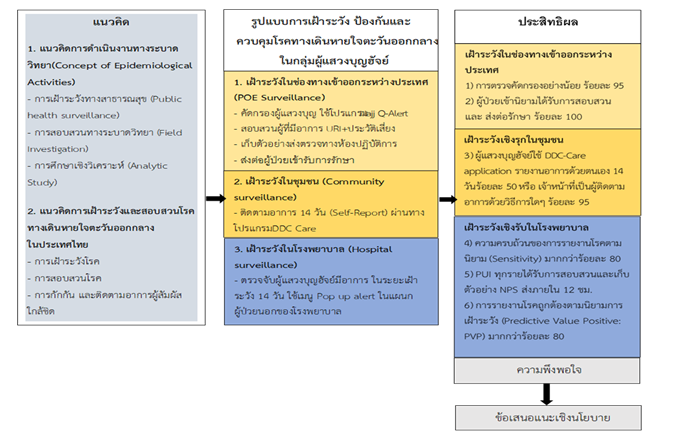การพัฒนารูปแบบการเฝ้าระวัง ป้องกัน และควบคุม โรคทางเดินหายใจตะวันออกกลาง (MERS-CoV) ในกลุ่มผู้แสวงบุญฮัจย์ พื้นที่ภาคใต้ตอนล่าง ประเทศไทย
คำสำคัญ:
การเฝ้าระวัง, ป้องกัน, ควบคุมโรค, โรคทางเดินหายใจตะวันออกกลาง, ผู้แสวงบุญ- ฮัจย์บทคัดย่อ
การศึกษานี้มีวัตถุประสงค์เพื่อศึกษาสภาพการณ์ ปัญหาการดำเนินงาน พัฒนารูปแบบ ประสิทธิผลของรูปแบบ และข้อเสนอแนะเชิงนโยบายการเฝ้าระวัง ป้องกัน และควบคุมโรคทางเดินหายใจตะวันออกกลาง ในกลุ่มผู้แสวงบุญฮัจย์ พื้นที่ภาคใต้ตอนล่าง ดำเนินการ 4 ขั้นตอน คือ ขั้นตอนที่ 1 สังเคราะห์สภาพการณ์ และปัญหา ใช้ระเบียบวิธีวิจัยเอกสาร ขั้นตอนที่ 2 พัฒนารูปแบบโดยผ่านการตรวจสอบจากผู้เชี่ยวชาญ ขั้นตอนที่ 3 ศึกษาประสิทธิผลของรูปแบบใช้ระเบียบวิธีวิจัยแบบกึ่งทดลองชนิดหนึ่งกลุ่มวัดผลหลังการทดลอง กลุ่มตัวอย่างเป็นผู้เดินทางไปแสวงบุญฮัจย์ ใน 7 จังหวัดภาคใต้ตอนล่าง และบุคลากร วิเคราะห์ข้อมูลโดยสถิติเชิงพรรณนา ขั้นตอนที่ 4 ศึกษาข้อเสนอแนะเชิงนโยบายจากผู้บริหาร ใช้ระเบียบวิธีวิจัยเชิงคุณภาพวิเคราะห์เนื้อหา ดำเนินการเดือนตุลาคม 2565 – เดือนสิงหาคม 2566 ผลวิจัยพบว่า
1. พื้นที่ภาคใต้ตอนล่าง ไม่มีรายงานผู้ป่วยที่ติดเชื้อ MERS-CoV ใช้รูปแบบแนวทางในการเฝ้าระวังของกรมควบคุมโรคแบบเชิงรับ ซึ่งไม่ครอบคลุมทุกกิจกรรมภายใน 14 วัน ของผู้แสวงบุญฮัจย์
2. รูปแบบการเฝ้าระวัง ป้องกันและควบคุมโรคทางเดินหายใจตะวันออกกลางในกลุ่มผู้แสวงบุญฮัจย์ พื้นที่ภาคใต้ตอนล่าง เป็น “MERS-PCH” ประกอบด้วยการเฝ้าระวังโรคใน 3 จุดที่สำคัญ คือ POE Surveillance (การเฝ้าระวังในช่องทางเข้าออกระหว่างประเทศ) Community Surveillance (การเฝ้าระวังในชุมชน) และ Hospital Surveillance (การเฝ้าระวังในโรงพยาบาล)
3. ประสิทธิผลของรูปแบบใหม่ คือ คัดกรองผู้เดินทางในสนามบิน 7,636 ราย (ร้อยละ 100) ตรวจจับ PUI MERS ได้ 53 ราย ทุกรายได้รับการสอบสวนโรค เจ้าหน้าที่ติดตามอาการในชุมชนได้ ร้อยละ 100 โรงพยาบาลรายงาน PUI MERS 53 ราย มีความไวของการตรวจจับร้อยละ 93.5 มีความถูกต้อง ร้อยละ 93.5 และสอบสวนโรคทันเวลาร้อยละ 100 ผลความพึงพอใจอยู่ในระดับมาก
4. ได้ให้คำแนะนำเชิงนโยบายในการขยายรูปแบบนี้ไปในจังหวัดอื่นที่มีผู้แสวงบุญฮัจย์ และสามารถขยายไปตรวจจับโรคอุบัติใหม่และอุบัติซ้ำที่จะเกิดขึ้นในประเทศไทยในอนาคตได้
ข้อเสนอแนะเชิงนโยบายโดยขยายรูปแบบนี้ไปใช้ในจังหวัดอื่นที่มีผู้แสวงบุญฮัจย์ และสามารถขยายผลสู่การตรวจจับโรคอุบัติใหม่และอุบัติซ้ำที่จะเกิดขึ้นในประเทศไทยในอนาคตได้
เอกสารอ้างอิง
Alagaili AN, Briese T, Mishra N, Kapoor V, Sameroff SC, de Wit E, et al. (2014). Middle East respiratory syndrome coronavirus infection in dromedary camels in Saudi Arabia. Retrieved May 25, 2023 from https://pubmed.ncbi.nlm.nih.gov/24570370/.
Arong, S. (2018). Surveillance evaluation of Middle East Respiratory Syndrome (MERS) in pilgrims travel to Mecca, Pattani province, Thailand, 2018. Province. Pattani: Pattani Provincial Public Health Office. (in Thai)
Bureau of Epidemiology Department of Disease Control. (2015). Guidelines for Surveillance and Investigation of Middle East Respiratory Diseases (Middle East Respiratory Syndrome: MERS) in Thailand. (October 2015 edition). Nonthaburi: Ministry of Public Health. (in Thai)
Centers of Disease Control and Prevention (2001). Updated guidelines for evaluating public health surveillance systems: recommendations from the guidelines working group. Retrieved May 24, 2023 from https://www.cdc.gov/mmwr/preview/mmwrhtml/rr5013a1.htm
Chantutanon, S. & Salae, F. (2016). Evaluation of the Middle East Respiratory Syndrome Surveillance System in Pilgrims, Satun Province, Thailand, 2016. Songkhla: Office of Disease Prevention and Control Region 12 Songkhla. (in Thai)
Division of International Disease Control Ports and Quarantine. (2022). Predictive and Risk Assessment for International Concern News Issue 3, 2023. Nonthaburi: Ministry of Public Health. (in Thai)
Division Of Islamic Organization and Hajj Affairs Promotion. (2023). News of the annual Hajj ceremony 2023. Bangkok: Ministry of Interior. (in Thai)
European Centre for Disease Prevention and Control. (2023). Geographical distribution of confirmed cases of MERS-CoV by reporting country, April 2012 – February 2023: Analysis and guidance. Retrieved May 24, 2023 from https://www.ecdc.europa.eu/en/publications-data/geographical-distribution-confirmed-cases-mers-cov-reporting-country-april-2012-2.
Maged Gomaa Hemida, Ali Mohamed Ali, Abdelmohsen Alnaeem. (2021). The Middle East respiratory syndrome coronavirus (MERS-CoV) nucleic acids detected in the saliva and conjunctiva of some naturally infected dromedary camels in Saudi Arabia -2019. Zoonoses and Public Health. Ministry of Health Malaysia. Guideline on Middle East Respiratory Syndrome (MERS) Management in Malaysia. Retrieved September 4, 2023 from https://www.moh.gov.my/index.php/database_stores/attach_download/681/210
M. Amin, A. Bakhtiar, M. Subarjo, E. Aksono, P. Widiyanti, K. Shimizu, et al. (2018). Screening for Middle East respiratory syndrome coronavirus among febrile Indonesian Hajj pilgrims: A study on 28,197 returning pilgrims. J Infect Prev, 19,(5): 236-239.
New Straits Times. (2023). Saudi approves 31,600 haj quota for Malaysia. Retrieved September 4, 2023 from https://www.nst.com.my/news/nation/2023/01/868875/saudi-approves-31600-haj-quota-malaysia Western Pacific
World Health Organization. (2015). Intensified public health measures help control MERS-CoV outbreak in the Republic of Korea: News. Retrieved May 25, 2023 from https://www.who.int/westernpacific/news/item/28-07-2015-intensified-public-health-measures-help-control-mers-cov-outbreak-in-the-republic-of-korea.
World Health Organization (2022). Disease Outbreak News; Middle East respiratory syndrome coronavirus (MERS-CoV) – Qatar. May 12, 2022. Retrieved August 29, 2023. From https://www.who.int/emergencies/disease-outbreak-news/item/2022-DON370
World Health Organization (2023). Disease Outbreak News; Middle East respiratory syndrome coronavirus (MERS-CoV).– Saudi Arabia. Retrieved August 29, 2023. from https://www.who.int/emergencies/disease-outbreak-news/item/2023-DON484
World Health Organization. (2023). MERS situation update, April 2023: Middle East respiratory syndrome. Retrieved May 25, 2023 from https://www.who.int/health-topics/mers-cov/mers-outbreaks.html.

ดาวน์โหลด
เผยแพร่แล้ว
ฉบับ
ประเภทบทความ
สัญญาอนุญาต
ลิขสิทธิ์ (c) 2023 วารสารเครือข่ายวิทยาลัยพยาบาลและการสาธารณสุขภาคใต้

อนุญาตภายใต้เงื่อนไข Creative Commons Attribution-NonCommercial-NoDerivatives 4.0 International License.
1. บทความหรือข้อคิดเห็นใด ๆ ที่ปรากฏในวารสารเครือข่าย วิทยาลัยพยาบาลและการสาธารณสุขภาคใต้ ที่เป็นวรรณกรรมของผู้เขียน บรรณาธิการหรือเครือข่ายวิทยาลัยพยาบาลและวิทยาลัยการสาธารณสุขภาคใต้ ไม่จำเป็นต้องเห็นด้วย
2. บทความที่ได้รับการตีพิมพ์ถือเป็นลิขสิทธิ์ของ วารสารเครือข่ายวิทยาลัยพยาบาลและการสาธารณสุขภาคใต้







